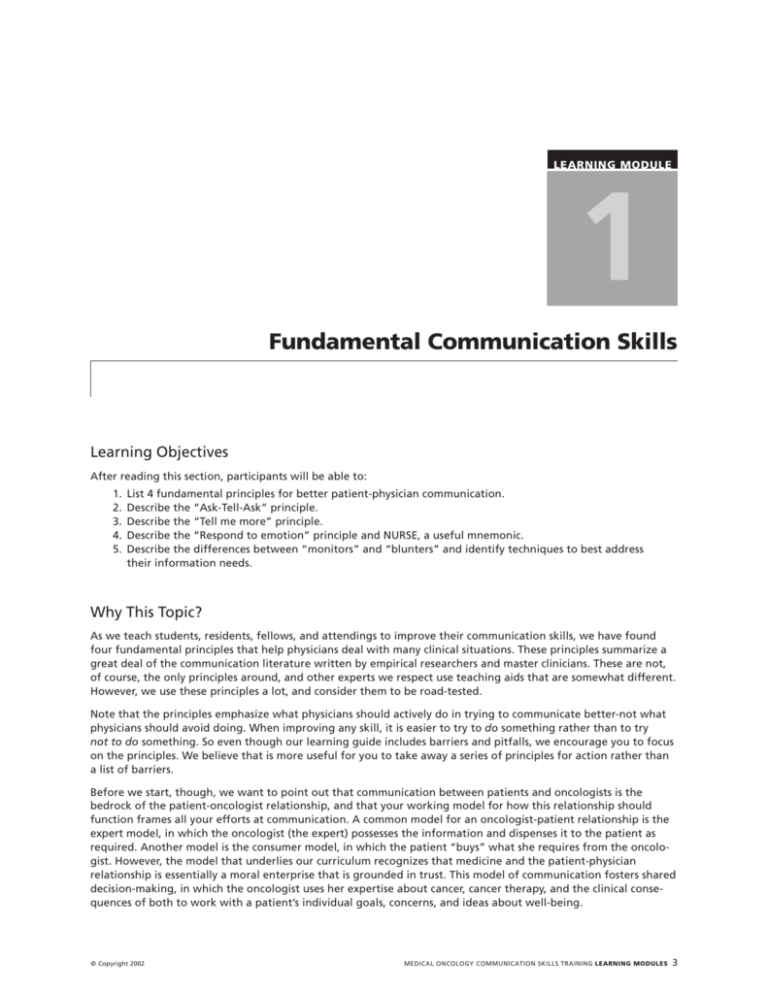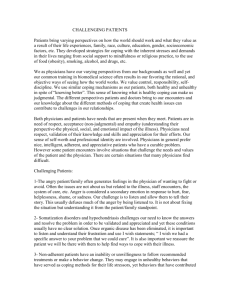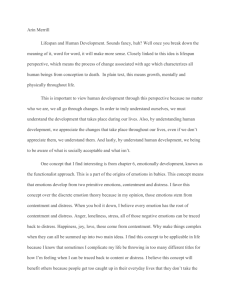Fundamental Communication Skills
advertisement

LEARNING MODULE 1 Fundamental Communication Skills Learning Objectives After reading this section, participants will be able to: 1. 2. 3. 4. 5. List 4 fundamental principles for better patient-physician communication. Describe the “Ask-Tell-Ask” principle. Describe the “Tell me more” principle. Describe the “Respond to emotion” principle and NURSE, a useful mnemonic. Describe the differences between “monitors” and “blunters” and identify techniques to best address their information needs. Why This Topic? As we teach students, residents, fellows, and attendings to improve their communication skills, we have found four fundamental principles that help physicians deal with many clinical situations. These principles summarize a great deal of the communication literature written by empirical researchers and master clinicians. These are not, of course, the only principles around, and other experts we respect use teaching aids that are somewhat different. However, we use these principles a lot, and consider them to be road-tested. Note that the principles emphasize what physicians should actively do in trying to communicate better-not what physicians should avoid doing. When improving any skill, it is easier to try to do something rather than to try not to do something. So even though our learning guide includes barriers and pitfalls, we encourage you to focus on the principles. We believe that is more useful for you to take away a series of principles for action rather than a list of barriers. Before we start, though, we want to point out that communication between patients and oncologists is the bedrock of the patient-oncologist relationship, and that your working model for how this relationship should function frames all your efforts at communication. A common model for an oncologist-patient relationship is the expert model, in which the oncologist (the expert) possesses the information and dispenses it to the patient as required. Another model is the consumer model, in which the patient “buys” what she requires from the oncologist. However, the model that underlies our curriculum recognizes that medicine and the patient-physician relationship is essentially a moral enterprise that is grounded in trust. This model of communication fosters shared decision-making, in which the oncologist uses her expertise about cancer, cancer therapy, and the clinical consequences of both to work with a patient’s individual goals, concerns, and ideas about well-being. © Copyright 2002 MEDICAL ONCOLOGY COMMUNICATION SKILLS TRAINING LEARNING MODULES 3 Every instance of communication could be described as a medical interview (although this term is a bit one-sided for our taste), in which three functions have been identified: 1. building the relationship, 2. assessing the patient’s problems, and 3. managing the patient’s problems. We assume that you already have these basic skills. Thus our “fundamentals” are really four second-level principles. Four Fundamental Principles for Better Communication Principle 1: “Ask-Tell-Ask” This principle is based on the notion that education requires knowing what the learner already knows and building on that knowledge. It also works as a way to build a relationship, as it shows that you are willing to listen to and negotiate the patient’s agenda. A great deal of communication in clinical oncology involves providing information, but this does not mean that communication should be largely one-way. For any important communication: ASK the patient to describe her current understanding of the issue. This will help you craft your message to take into account the patient’s level of knowledge, emotional state, and degree of education. “Ask” also gives you the opportunity to determine why the patient is at the appointment and then negotiate (tell-ask) the agenda for the visit. Some sample questions to open your conversation include: • • • • • “What brings you here today?” “Anything else?” “What is the most important issue for us to talk about today?” “To make sure we are on the same page, can you tell me what your understanding of your disease is?” “What have your other doctors been telling you about your illness since the last time we spoke?” After you have done this, the next step is to… TELL the patient in straightforward language what you need to communicate-the bad news, or treatment options, or other information. Stop short of giving a long lecture or huge amounts of detail. Information should be provided in short, digestible chunks. A rule of thumb is not to give more than three pieces of information at a time. Use ninth grade English in communicating. Avoid medical-ese. Before you go on, you should… ASK the patient if she understood what you just said. This gives you the opportunity to check her understanding. Did she get the facts straight? Is her understanding appropriate? Did she hear what was said? Consider asking the patient to restate what was said in her own words. This will give her a chance to ask her questions, and that will tell you where to go next-what details to elaborate, what implications to discuss, what things to repeat. For example, you could say “Who are you going to tell about this visit when you get home?” or “To make sure I did a good job of explaining to you, can you tell me what you are going to say?” Or at the next visit, you could start out with “I am not sure I was clear at our last visit when I explained the problems to you. To help me out, can you tell me what you remember I told you about your disease?” Principle 2: When you are stuck, ask for more information: “Tell me more” If you find that the conversation is going off track, it is helpful to note that in your own mind and you may even want to mention it to the patient (for example, “I think we’re not on the same track”). To get back on track, it is usually helpful to invite the patient to explain where he is in the conversation, and to remember that every conversation really has at least 3 levels: 1. The first level of conversation could be called the “What is happening?” conversation, in which the patient is trying to apprehend and understand information. 2. The second level of conversation has to do with emotions-at this deeper level, a patient is asking himself “How do I feel about this?” In addition to trying to figure out his emotions, he is also assessing whether they are valid, and whether he can express them to the oncologist. 3. The third level of conversation is an identity conversation, involving what the new information means in terms of the patient’s sense of self-addressing the question “What does this mean to me?” 4 MEDICAL ONCOLOGY COMMUNICATION SKILLS TRAINING LEARNING MODULES © Copyright 2002 Knowing that these three different conversations are taking place can enlarge a physician’s sense of where the “tell me more” request can lead. Some examples of useful invitations to “tell me more” include: • “Could you tell me more about what information you need at this point?” • “Could you say something about how you are feeling about what we have discussed?” • “Could you tell me what this means for you and your life?” Principle 3: Respond to emotion Understanding the patient’s perspective will result in physicians discovering more about the thoughts and feelings patients are experiencing. Having discovered all this, how should physicians respond? The concept of an “accepting response” is helpful here. Rather than providing immediate reassurance, rebuttal, or agreement, the accepting response: a. accepts what the patient says non-judgmentally, b. acknowledges that patients ought to hold their own views and feelings, and c. validates the importance of the patient’s contributions in a therapeutic relationship. It is important to note that acceptance is not the same as agreement. A physician could accept that a patient wishes to be cured of cancer, yet not agree that it is possible. This distinction is important is building and maintaining a relationship. A helpful mnemonic summarizes what to do in responding and accepting patient emotions: NURSE N = NAMING. You can begin by naming a patient emotion for yourself, as a way of noting what is happening in the encounter, and you may even want to name the emotion as to talk to the patient, as a way of showing that you are attuned to what she is experiencing (“It sounds like you are worried that the cancer may be recurring.”). Naming, restating, and summarizing are all ways to begin accepting and responding to patient emotions. This may require that physicians read non-verbal clues that patients display. It is important that when using naming, the physician is suggestive, not declarative. “I wonder if you’re feeling angry,” or “Some people in this situation would be angry,” rather than “I can see you’re angry about this.” People don’t like being told what they are feeling. U = UNDERSTANDING. A sensitive appreciation of the patient’s predicament or feelings is an important prerequisite for responding in a way that builds the relationship. Particularly important is to avoid giving premature reassurance at this point, even though the temptation to do this is strong. It is better to make sure that you have a clear understanding, and this may require some exploration, active listening, and use of silence. “I think I’m understanding you to say that you are concerned about the effect of the chemotherapy on your kids” can be an effective way to validate patient emotions. Paradoxically, saying “I cannot imagine what it is like to (X)” is a good way to show you understand. R = RESPECTING. This can be a non-verbal response, involving facial expression, touch, or change in posture, but a verbal response is helpful because it can be more explicit in giving patients the message that their emotions are not only allowable but important. Acknowledging and respecting a patient’s emotions is an important step in showing empathy. In terms of how much to do on this step, consider matching the intensity of your acknowledgment to the patient’s expression of emotion-a strong emotion deserves a strong acknowledgment. Praising the person’s coping skills is a good way to show respect. “I am very impressed with how well you’ve cared for your mother during this long illness. You have been a godsend for her.” This really makes people feel good about themselves and implies respect. S = SUPPORTING. Several types of supporting statements are possible. Physicians can express concern, articulate their understanding of a patient’s situation, express willingness to help, make statements about partnership, and most importantly, acknowledge the patient’s efforts to cope. Given that many dying patients fear abandonment, making statements-if truthful-that you will be there for the patient are very useful, e.g., “I’ll be with you during this illness, no matter what happens.” E = EXPLORING. The most effective empathic statements link the “I” of the doctor to the “you” of the patient: “I sense how upset you are feeling about the results of the CT scan.” It is not necessary to have had the experience to empathize; but it is necessary to put yourself in the patient’s position and to communicate that understanding back to the patient. Also, empathy should not be confused with sympathy, which is a feeling of pity or concern from outside the patient’s position. © Copyright 2002 MEDICAL ONCOLOGY COMMUNICATION SKILLS TRAINING LEARNING MODULES 5 Principle 4: Assess the patient’s coping style Psychologists have identified two main coping styles: monitors and blunters. Patients who use problem-focused coping have been termed “monitors,” who typically seek information to help them manage. Monitors are very interested in planning ahead, and are highly problem focused. In particular, monitors may find that as their cancer progresses beyond the possibility of cure, they may hit a wall in seeking information. With these patients, it may be helpful to limit or contain their information seeking and gently shift them towards acknowledging their emotions (NURSE). Patients who use emotion-focused coping are termed “blunters,” who tend to cope by avoiding information, distancing themselves, and engaging in denial of their situation. Blunters often avoid practical planning, which almost ensures that others will be making decisions for them at the end of their lives. With these patients, it may be necessary to contain their emotions and shift them towards information and practical planning using “ask-tellask.” Although these patients are said to be emotion-focused, they may not be ready to go beyond denial with you until they have developed a very high level of trust. It may be counterproductive to use NURSE repeatedly in the early stages of your relationship with a blunter. Pitfalls/Common Barriers to Good Communication • • • • • Giving pathophysiology lectures. Ignoring the context of the communication encounter. Not finding out the patient’s information needs. Launching into your agenda first without negotiating the focus of the interview. Offering reassurance prematurely. REFERENCES Included in this notebook 1. Spiegel D. “A 43 year-old woman coping with cancer.” JAMA, 1999; 282(4):371-8. 2. Fallowfield L, Jenkins V, Farewell V, Saul J, Duffy A, Eves R. “Efficacy of a cancer research UK communication skills training model for oncologists: A randomised controlled trial.” Lancet, 2002; 359:650-6. 3. Quill, TE. “Recognizing and adjusting to barriers in doctor-patient communication.” Ann Intern Med, 1989; 111(1):51-7 Additional references (not included) 1. Cole SA, Bird J. The Medical Interview: The Three-Function Approach. Mosby: St. Louis, 2000. 2. Platt FW, Gordon GH. The Field Guide to the Difficult Patient Interview. Lippincott Williams & Wilkins: Philadelphia, 1999. 6 MEDICAL ONCOLOGY COMMUNICATION SKILLS TRAINING LEARNING MODULES © Copyright 2002







